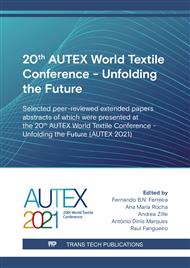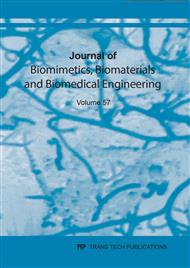[1]
X. Song, L. Melro, J. Padrão, A.I. Ribeiro, Z. He, L. Yu, A. Zille, Nonwoven materials and technologies for medical applications, in: M.I.H. Mondal (Ed.), Fundamentals of Natural Fibers and Textiles/ Antimicrobial Textiles from Natural Resources, In Press (2021).
DOI: 10.1016/b978-0-323-90479-7.00008-7
Google Scholar
[2]
E. Ricciotti, G.A. FitzGerald, Prostaglandins and Inflammation, Arterioscler. Thromb. Vasc. Biol. 31(5) (2011) 986-1000.
Google Scholar
[3]
K. Raziyeva, Y. Kim, Z. Zharkinbekov, K. Kassymbek, S. Jimi, A. Saparov, Immunology of Acute and Chronic Wound Healing, Biomolecules 11(5) (2021).
DOI: 10.3390/biom11050700
Google Scholar
[4]
S. Guo, L.A. DiPietro, Factors Affecting Wound Healing, J. Dent. Res. 89(3) (2010) 219-229.
DOI: 10.1177/0022034509359125
Google Scholar
[5]
S.S. Mathew-Steiner, S. Roy, C.K. Sen, Collagen in Wound Healing, Bioeng. 8(5) (2021).
Google Scholar
[6]
C.J. van Koppen, R.W. Hartmann, Advances in the treatment of chronic wounds: a patent review, Expert Opin. Ther. Pat. 25(8) (2015) 931-937.
DOI: 10.1517/13543776.2015.1045879
Google Scholar
[7]
S.L. Percival, S.M. McCarty, B. Lipsky, Biofilms and Wounds: An Overview of the Evidence, Adv. wound care 4(7) (2015) 373-381.
DOI: 10.1089/wound.2014.0557
Google Scholar
[8]
R. Serra, R. Grande, L. Butrico, A. Rossi, U.F. Settimio, B. Caroleo, B. Amato, L. Gallelli, S. de Franciscis, Chronic wound infections: the role of Pseudomonas aeruginosa and Stap hylococcus aureus, ERATCK 13(5) (2015) 605-613.
DOI: 10.1586/14787210.2015.1023291
Google Scholar
[9]
L.J. Bessa, P. Fazii, M. Di Giulio, L. Cellini, Bacterial isolates from infected wounds and their antibiotic susceptibility pattern: some remarks about wound infection, Int. Wound J. 12(1) (2015) 47-52.
DOI: 10.1111/iwj.12049
Google Scholar
[10]
G.R. Tortella, O. Rubilar, M.C. Diez, J. Padrão, A. Zille, J.C. Pieretti, A.B. Seabra, Advanced Material Against Human (Including Covid‐19) and Plant Viruses: Nanoparticles As a Feasible Strategy, Global Challenges 5(3) (2020).
DOI: 10.1002/gch2.202000049
Google Scholar
[11]
A. Molinas, M.V. Turkina, K.-E. Magnusson, A. Mirazimi, E. Vikström, Perturbation of Wound Healing, Cytoskeletal Organization and Cellular Protein Networks during Hazara Virus Infection, Front. Cell Dev. Biol. 5 (2017).
DOI: 10.3389/fcell.2017.00098
Google Scholar
[12]
R. Rebelo, J. Padrão, M.M. Fernandes, S. Carvalho, M. Henriques, A. Zille, R. Fangueiro, Aging Effect on Functionalized Silver-Based Nanocoating Braided Coronary Stents, Coatings 10(12) (2020).
DOI: 10.3390/coatings10121234
Google Scholar
[13]
O. Betzer, M. Shilo, R. Opochinsky, E. Barnoy, M. Motiei, E. Okun, G. Yadid, R. Popovtzer, The effect of nanoparticle size on the ability to cross the blood–brain barrier: an in vivo study, Nanomedicine 12(13) (2017) 1533-1546.
DOI: 10.2217/nnm-2017-0022
Google Scholar
[14]
A. Zille, M.M. Fernandes, A. Francesko, T. Tzanov, M. Fernandes, F.R. Oliveira, L. Almeida, T. Amorim, N. Carneiro, M.F. Esteves, A.P. Souto, Size and Aging Effects on Antimicrobial Efficiency of Silver Nanoparticles Coated on Polyamide Fabrics Activated by Atmospheric DBD Plasma, ACS Appl. Mater. Interfaces 7(25) (2015) 13731-13744.
DOI: 10.1021/acsami.5b04340
Google Scholar
[15]
S.H. Ching, N. Bansal, B. Bhandari, Alginate gel particles–A review of production techniques and physical properties, Crit. Rev. Food Sci. Nutr. 57(6) (2015) 1133-1152.
DOI: 10.1080/10408398.2014.965773
Google Scholar
[16]
X. Gao, C. Guo, J. Hao, Z. Zhao, H. Long, M. Li, Adsorption of heavy metal ions by sodium alginate based adsorbent-a review and new perspectives, Int. J. Biol. Macromol. 164 (2020) 4423-4434.
DOI: 10.1016/j.ijbiomac.2020.09.046
Google Scholar
[17]
J. Weitkamp, Zeolites and catalysis, Solid State Ionics 131(1-2) (2000) 175-188.
DOI: 10.1016/s0167-2738(00)00632-9
Google Scholar
[18]
Y. Wan, Z. Guo, X. Jiang, K. Fang, X. Lu, Y. Zhang, N. Gu, Quasi-spherical silver nanoparticles: Aqueous synthesis and size control by the seed-mediated Lee–Meisel method, J. Colloid Interface Sci. 394 (2013) 263-268.
DOI: 10.1016/j.jcis.2012.12.037
Google Scholar
[19]
C.M. Botelho, M.M. Fernandes, J.M. Souza, N. Dias, A.M. Sousa, J.A. Teixeira, R. Fangueiro, A. Zille, New Textile for Personal Protective Equipment-Plasma Chitosan/Silver Nanoparticles Nylon Fabric, Fibers 9(1) (2021).
DOI: 10.3390/fib9010003
Google Scholar
[20]
C.A. Schneider, W.S. Rasband, K.W. Eliceiri, NIH Image to ImageJ: 25 years of image analysis, Nat. Meth. 9(7) (2012) 671-675.
DOI: 10.1038/nmeth.2089
Google Scholar
[21]
J. Padrão, S. Ribeiro, S. Lanceros-Méndez, L.R. Rodrigues, F. Dourado, Effect of bacterial nanocellulose binding on the bactericidal activity of bovine lactoferrin, Heliyon 6(7) (2020).
DOI: 10.1016/j.heliyon.2020.e04372
Google Scholar
[22]
N. Durán, M. Durán, M.B. de Jesus, A.B. Seabra, W.J. Fávaro, G. Nakazato, Silver nanoparticles: A new view on mechanistic aspects on antimicrobial activity, Nanomedicine: Nanotechnology, Biology and Medicine 12(3) (2016) 789-799.
DOI: 10.1016/j.nano.2015.11.016
Google Scholar
[23]
A. Zille, F.R. Oliveira, A.P. Souto, Plasma Treatment in Textile Industry, Plasma Process. Polym. 12(2) (2015) 98-131.
DOI: 10.1002/ppap.201400052
Google Scholar
[24]
J. You, Y. Zhang, Z. Hu, Bacteria and bacteriophage inactivation by silver and zinc oxide nanoparticles, Colloids Surf. B 85(2) (2011) 161-167.
DOI: 10.1016/j.colsurfb.2011.02.023
Google Scholar



